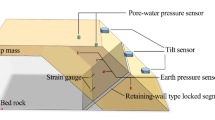Abstract
This paper presents a geomechanical model test for analyzing rainfall-induced slope instability. The proposed method integrates HCA726S tilt sensors, micro soil pressure sensors, pore water pressure sensors, three-dimensional laser scanners, and other instruments to monitor tilt angle, stress, vertical displacement, and morphology of the slope. The tilting deformation and stress response were analyzed, and the landslide evolution process is summarized. Based on the tilt deformation curves obtained from the tilt sensors, it can be concluded that shallow landslide exhibits creep characteristics, and the creep behavior can be divided into three stages: primary, secondary, and tertiary creep. A linear relationship between the reciprocal tilting rate and time was observed during the primary and tertiary creep stages, and a linear equation was established. A reciprocal tilting rate of 0 min/° was then input into the linear equation to obtain the time of initial and complete slope failure. The predicted landslide failure times were consistent with the actual recorded times obtained from the model tests. Thus, tilt deformation is a significant early warning indicator or slope instability and could be used to predict landslides for disaster prevention and mitigation.












Similar content being viewed by others
Data availability
All data are available in the paper or from the corresponding author on request.
References
D Abhirup ND Satyam I Towhata 2018 Early warning system using tilt sensors in Chibo, Kalimpong, Darjeeling Himalayas India Nat Hazards 94 727 741 https://doi.org/10.1007/s11069-018-3417-6
Aleotti P (2004) A warning system for rainfall-induced shallow failures. Eng Geol 73(3–4):247–265. https://doi.org/10.1016/j.enggeo.2004.01.007
Angeli MG, Pasuto A, Silvano S (2010) A critical review of landslide monitoring experiences. Eng Geol 55(3):133–147. https://doi.org/10.1016/S0013-7952(99)00122-2
Bai S, Jian W, Thiebes B, Chen C (2014) Analysis of the relationship of landslide occurrence with rainfall: a case study of Wudu County. China Arab J Geosci 7(4):1277–1285. https://doi.org/10.1007/s12517-013-0939-9
Baum RL, And J, Savage WZ (2010) Estimating the timing and location of shallow rainfall-induced landslides using a model for transient, unsaturated infiltration. J Geophys Res Earth Surface https://doi.org/10.1029/2009JF001321
RI Borja JA White X Liu W Wu 2011 Factor of safety in a partially saturated slope inferred from hydro-mechanical continuum modeling Int J Numer Anal Meth Geomechhttps://doi.org/10.1002/nag.1021
Brand EW, Premchitt J, Phillipson HB (1984) Relationship between rainfall and landslides in Hong Kong.
Brunetti MT, Peruccacci S, Rossi M, Luciani S, Valigi D, Guzzetti F (2010) Rainfall thresholds for the possible occurrence of landslides in Italy. Nat Hazard 10(3):447–458. https://doi.org/10.5194/nhess-10-447-2010
China Institute of Geohazard and Environment Monitoring (2019) China bulletin of geological hazards. China Geological Environment Information Network, http://219.142.70.148/auto/db/detail.aspx?db=1006&rid=48834&agfi=0&cls=0&uni=False&cid=0&showgp=False&prec=False&md=29&pd=210&msd=11&psd=5&mdd=11&pdd=5&count=20
Casagli N, Catani F, Ventisette CD, Luzi G (2010) Monitoring, prediction, and early warning using ground-based radar interferometry. Landslides 7(3):291–301. https://doi.org/10.1007/s10346-010-0215-y
Chae BG, Park HJ, Catani F, Simoni A, Berti M (2017) Landslide prediction, monitoring and early warning: a concise review of state-of-the-art. Geosci J 21(6):1033–1070. https://doi.org/10.1007/s12303-017-0034-4
Chen H, Tang H, Ge X, Li Y (2019) Research on early warning index and early warning forecast of creep landslide based on deep displacement. Chin J Rock Mech Eng A01:3015–3024
A Dikshit DN Satyam I Towhata 2018 Early warning system using tilt sensors in Chibo, Kalimpong, Darjeeling Himalayas, India[J] Nat Hazards https://doi.org/10.1007/s11069-018-3417-6
Fan X, Tang J, Tian S, Jiang Y (2020) Rainfall-induced rapid and long-runout catastrophic landslide on July 23, 2019 in Shuicheng, Guizhou, China. Landslides 17 2 https://doi.org/10.1007/s10346-020-01454-
G Fausto P Silvia R Mauro CP Stark 2008 The rainfall intensity–duration control of shallsow landslides and debris flows: an update Landslides https://doi.org/10.1007/s10346-007-0112-1
Fei Ye, Wen-Xi Fu, Hong-Fu Zhou, Yue Liu, Zheng R-JBS (2021) The “8·21” rainfall-induced Zhonghaicun landslide in Hanyuan County of China: surface features and genetic mechanisms. Landslides 1 14 https://doi.org/10.1007/s10346-021-01722-5
Gao Y, Yin Y, Li B, Feng Z, Wang W, Zhang N, Xing A (2017) Characteristics and numerical runout modeling of the heavy rainfall-induced catastrophic landslide–debris flow at Sanxicun, Dujiangyan, China, following the Wenchuan Ms 8.0 earthquake. Landslides https://doi.org/10.1007/s10346-016-0793-4
Glade T (2000) Applying probability determination to refine landslide-triggering rainfall thresholds using an empirical “Antecedent Daily Rainfall Model.” Pure Appl Geophys 157(6–8):1059–1079. https://doi.org/10.1007/s000240050017
Huang R (2007) Large-scale landslides and their sliding mechanisms in China since 20th century. Chin J Rock Mech Eng 26(003):433–454
Intrieri E, Gigli G, Mugnai F, Fanti R, Casagli N (2012) Design and implementation of a landslide early warning system. Engineering Geology 147–148(none)https://doi.org/10.1016/j.enggeo.2012.07.017
RM Iverson ME Reid 2000 Acute sensitivity of landslide rates to initial soil porosity Science https://doi.org/10.1126/science.290.5491.513
Iverson RM (2000) Landslide triggering by rain infiltration. Water Resources Research 3610.1029/2000WR900090
Iverson RM, Logan M, Denlinger RP (2004) Granular avalanches across irregular three-dimensional terrain: 2. Experimental tests. Journal of Geophysical Research Atmospheres 109(F1)https://doi.org/10.1029/2003JF000084
Iverson RM, Reid M, Iverson NR, LaHusen R, Logan M, Mann J, Brien D (2000) Acute sensitivity of landslide rates to initial soil porosity. Science 290 5491 513 516 https://doi.org/10.1126/science.290.5491.513
Iverson RM, Reid ME, Logan M, Lahusen RG, Griswold JP (2011) Positive feedback and momentum growth during debris-flow entrainment of wet bed sediment. Nat Geosci 4(2):116–121. https://doi.org/10.1038/ngeo1040
Lee K, Suk J, Kim H, Jeong S (2020) Modeling of rainfall-induced landslides using a full-scale flume test. Landslides 1:1–10. https://doi.org/10.1007/s10346-020-01563-8
Li HB, Xu YR, Zhou JW, Wang XK, Dou J (2020) Preliminary analyses of a catastrophic landslide occurred on July 23, 2019, in Guizhou Province. China Landslides 17(3):719–724. https://doi.org/10.1007/s10346-019-01334-0
Liu Q (2019) Landslide in Zaoling Township, Xiangning County, Shanxi Province. Chin J Geohazard Prevent 30(02):12, CNKI:SUN:ZGDH.0.2019–02–022
Luo XQ (2008) Landslide model test theory and its application. China WaterPower Press, China WaterPower Press
Popescu ME (2002) Landslide causal factors and landslide remedial options, Keynote lecture. In: Proceedings 3rd international conference on landslide, slope stability and safety of infrastructures.
Saito H, Korup O, Uchida T, Hayashi S, Oguchi T (2014) Rainfall conditions, typhoon frequency, and contemporary landslide erosion in Japan. Geology 42(11):999–1002. https://doi.org/10.1130/G35680.1
Saito M (1969) Research on forecasting the time of occurrence of slope failure. 土と基礎 17:29–38,
Sasaki, and Fujii, and Asai 2000 Soil creep process and its role in debris slide generation—field measurements on the north side of Tsukuba Mountain in Japan EngGeol https://doi.org/10.1016/S0013-7952(99)00141-6
Shao W, Junjun NI, Leung AK, Ye SU, Ng CWW (2017) Analysis of plant root-induced preferential flow and pore water pressure variation by a dual-permeability model. Can Geotech J (11)https://doi.org/10.1139/cgj-2016-0629
Shen D, Shi Z, Peng M, Zhang L, Zhu Y (2020) Preliminary analysis of a rainfall-induced landslide hazard chain in Enshi City, Hubei Province, China in July 2020. Landslides 18(6):1–4. https://doi.org/10.1007/s10346-020-01553-w
Sidle RC, Bogaard TA (2016) Dynamic earth system and ecological controls of rainfall-initiated landslides. Earth Sci Rev 159:275–291. https://doi.org/10.1016/j.earscirev.2016.05.013
Sun H, Jie Z, Yu Z, Shen S, Shang Y (2013) The influence of localized slumping on groundwater seepage and slope stability. J Earth Sci 24(1):104–110. https://doi.org/10.1007/s12583-013-0307-4
Taylor DW (1948) Fundamentals of Soil Mechanics. Soil Ence 66(2):161. https://doi.org/10.1007/978-94-017-9460-2_4
Towhata I, Uchimura T, Gallage C. On early detection and warning against rainfall-induced landslides (M129) [J]. Springer Berlin Heidelberg, 2005. https://doi.org/10.1007/3-540-28680-2_16
Uchimura T, Towhata I, Anh T, Fukuda J, Bautista C, Lin W, Seko I, Uchida T, Matsuoka A, Ito Y (2010) Simple monitoring method for precaution of landslides watching tilting and water contents on slopes surface. Landslides 7(3):351–357. https://doi.org/10.1007/s10346-009-0178-z
Uchimura T, Towhata I, Wang L, Nishie S, Yamaguchi H, Seko I, Qiao J (2015) Precaution and early warning of surface failure of slopes using tilt sensors. Soils Found 55(5):1086–1099. https://doi.org/10.1016/j.sandf.2015.09.010
Wang L (2019) The 7. 23 landslide in Shuicheng, Guizhou province. Chinese Journal of Geohazard and Prevention v.30;No.122(04):12–12, CNKI:SUN:ZGDH.0.2019–04–02
Wang M, Xie M, Hu M (2015) Study on landslide threatening warning method based on surface inclination change. Science & Technology Vision (2):133–134, CNKI:SUN:KJSJ.0.2015–02–096
J Xie T Uchimura P Chen J Liu C Xie Q Shen 2019 A relationship between displacement and tilting angle of the slope surface in shallow landslides Landslideshttps://doi.org/10.1007/s10346-019-01135-5
Xie J, Uchimura T, Wang G, Shen Q, Maqsood Z, Xie C, Liu J, Lei W, Tao S, Chen P (2020) A new prediction method for the occurrence of landslides based on the time history of tilting of the slope surface. Landslides 17(2):301–312. https://doi.org/10.1007/s10346-019-01283-8
Xu Q (2012) Theoretical studies on prediction of landslides using slope deformation process data. J Eng Geol 20(2):145–151
F Ye W Fu X Yuan Y Xiang 2019 Drag Force Effect of Surface Run off on Stability of Shallow Soil Slope Soil Mechanics and Foundation Engineering 56 1 12 20 https://doi.org/10.1007/s11204-019-09563-0
Yin Y, Zheng W, Liu Y, Zhang J, Li X (2010) Integration of GPS with InSAR to monitoring of the Jiaju landslide in Sichuan. China Landslides 7(3):359–365. https://doi.org/10.1007/s10346-010-0225-9
Zhang LL, J., Zhang, M., Zhang, W., H., Tang (2011) Stability analysis of rainfall–induced slope failure: a review. Proc Inst Civ Eng Geotech Eng
Acknowledgements
This work was supported by the National Key Research and Development Program (Grant No. 2019YFC1509704) and National Natural Science Foundation of China (Grant No. U1704243).
Author information
Authors and Affiliations
Corresponding author
Ethics declarations
Conflict of interest
The authors declare no competing interests.
Additional information
Responsible Editor: Zeynal Abiddin Erguler
Rights and permissions
About this article
Cite this article
Liu, H., Liu, Jj., Chen, J. et al. Tilt deformation and instability of the slope for predicting rainfall-induced landslide. Arab J Geosci 15, 257 (2022). https://doi.org/10.1007/s12517-021-09338-8
Received:
Accepted:
Published:
DOI: https://doi.org/10.1007/s12517-021-09338-8




